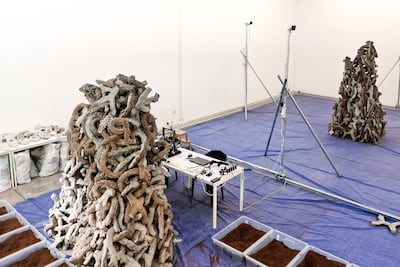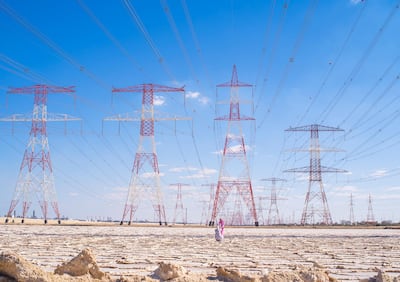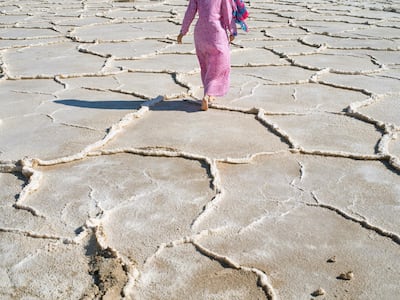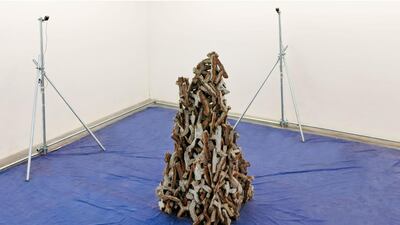A large-scale structure made of environmentally friendly cement will be showcased at the UAE's National Pavilion at the upcoming Venice Architecture Biennale.
The cement is created from recycled, industrial-waste brine derived from the UAE's salt flats, known as sabkha, which account for more than 5 per cent of the country’s land mass.
The salt-based installation will be unveiled at the 17th International Architecture Exhibition of the Venice Biennale, which runs from May 22 to November 21.
It will be exhibited as part of architects Wael Al Awar and Kenichi Teramoto's Wetland, which looks at how salt compounds in the UAE's salt flats can be used as renewable building materials.
The structure will tower seven metres high and five metres wide, housing a walkable interior the size of an average room. The structure will be formed from up to 3,000 modules of a magnesium oxide-based cement designed by Al Awar and Teramoto, curators of the National Pavilion.

The curators worked with specialist teams at NYU Abu Dhabi’s Amber Lab, the American University of Sharjah’s department of biology, chemistry and environmental sciences, and the University of Tokyo’s Obuchi Lab and Sato Lab to develop the chemical formula for the cement.
Their research aims to find a solution to the environmental problems brought on by the manufacture of concrete. Cement is one of the most used substances on Earth, second only to water. But its production has a high environmental impact, releasing a substantial amount of carbon dioxide into the air and accounting for 8 per cent of all greenhouse emissions.
In contrast, sabkha-based building materials, such as the cement with which Teramoto and Al Awar are experimenting, absorb carbon dioxide as they cure.
Researchers used advanced digital engineering technology to formulate a viable structure made from the sabkha cement. Early prototypes of the seven-metre structure will be on display at the Wetland Research Lab in Dubai’s Alserkal Avenue.

“Our MgO cement is made from brine left over during industrial desalination, a resource that the UAE has in abundance,” Al Awar and Teramoto said in a statement.
“It has the strength and durability to be used in modern architecture in standard brick shapes. For this exhibition, we have been inspired by the UAE’s traditional vernacular architecture of coral houses, to hand-cast modules in organic, coral-inspired shapes.
"In this way, we are reimagining modern architectural processes and retaining a strong, poetic sense of the region’s identity and culture within the structure.”
The structure will be exhibited at the National Pavilion against a backdrop of three large photographs taken by artist Farah Al Qasimi.
The scenic photographs each measure three metres high and more than four metres wide. They show transmission towers standing tall above the textured salt flats, exploring the tension between urbanisation and nature in the UAE’s sabkha.

“The scenery of the sabkha sites presents a moment of conflict and resolution,” Al Qasimi said in a statement.
“On and below the earth, the sabkha is a serene living environment with many layers of water, sand, salt and micro-organisms which have evolved in harmony to create a delicate ecological system that absorbs more carbon per square metre than the rainforest."
Yet, as the artist notes, running above this "natural phenomenon" are voltage cables running to nearby industrial facilities.
"My photographs of the site capture this tension between industrialisation and the environment. I’m very proud to be contributing to the UAE’s pavilion, working with a cosmopolitan research team that really reflects the nation’s diversity," Al Qasimi added.
Laila Binbrek, co-ordinating director of the National Pavilion, said Wetland will mark the UAE's 10th participation in the Venice Biennale, set against the context of the UAE's 50th national anniversary.

“The exhibition presents a truly groundbreaking potential solution to the global issue of climate change, through a project that is rooted in our local stories, environment and society – reflecting the National Pavilion UAE’s commitment to tell the UAE’s untold stories while facilitating global dialogue,” Binbrek said.
The exhibition will also include a three-minute soundtrack capturing the ecological story of the sabkhas, the desalination process that creates brine and the exhibition’s research journey.
An accompanying publication titled The Anatomy of Sabkhas, written by urban researchers Rashid and Ahmed bin Shabib and co-edited by Al Awar and Teramoto, will explore the ecological and socio-economic significance of these natural phenomena.
A supplementary volume edited and written by Aga Khan Award-winning architect Marina Tabassum will detail the journey of Wael and Teramoto's research for the Wetland exhibition.


